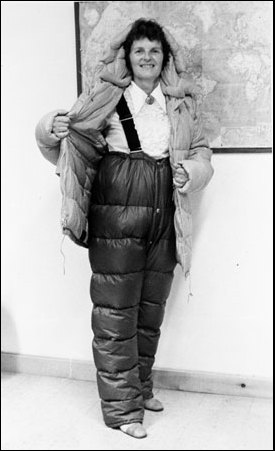Born in Bradford, Vt., mineralogist, meteoriticist, polymath, and Antarctic adventurer Ursula Marvin graduated in 1943 from Tufts University in Medford, Mass. Rather than a bachelor’s degree in geology, which she would have preferred, Ursula earned one in history because her adviser thought geology was an unsuitable profession for a woman. Nonetheless, Ursula had amassed enough undergraduate science credits to be accepted into a geology graduate program at Radcliffe College, where she received a master’s degree in 1946. She went on to study for her doctorate at Harvard University, where she met and married fellow student Thomas C. Marvin in 1952. She received her Ph.D. in 1969, but before that, Ursula and Tom had been recruited by Union Carbide Corporation to prospect for manganese ore in Portuguese Angola and Brazil.
In 1958, Ursula returned to Harvard to study under Clifford Frondel, until Fred Whipple, director of the nearby (approximately 1 kilometer away) Smithsonian Astrophysical Observatory (SAO), asked her to join the observatory to provide mineralogical support to isotope physicist Edward Fireman. She accepted a civil service position at SAO in 1961. The observatory’s satellite-tracking program at that time informed the science of geodesy and reawakened interest in the concept of continental drift, a topic about which Ursula wrote a 1973 book entitled Continental Drift: The Evolution of a Concept.
Analyzing Apollo 11 Moon Rock FragmentsIn the 1960s, as well, NASA invited appropriately trained scientists to submit proposals to study the lunar samples that they expected the astronauts of the Apollo missions to collect. Ursula supplied the mineralogical and X-ray diffraction expertise for what became a successful proposal by John Wood’s SAO research group. Beginning in 1969, the SAO team made population studies of small (1- to 2-millimeter) rock fragments in the regolith sample that the Apollo 11 astronauts collected. The analysts discovered an unexpected component of white anorthosite-rich lithologies that must have been derived from the high-albedo lunar crustal highlands. From this finding, they concluded that magmatic fractionation of anorthosite must have occurred in an early Moon that was largely or wholly melted.
Ursula spent much of the Apollo program at the NASA Manned Spacecraft Center (known today as the Johnson Space Center) in Houston, Texas, with her arms in a glove box and her eyes socketed to a binocular microscope. She was participating in the space agency’s Lunar Sample Preliminary Examination Team, dictating as much about the minerals in the larger lunar rock samples as could be learned by eyeballing them.
Antarctic Meteorite Hunts Ursula Marvin displays her Antarctic gear before the 1978 meteorite hunt. Credit: Smithsonian Institution Archives, #96-1022
Ursula Marvin displays her Antarctic gear before the 1978 meteorite hunt. Credit: Smithsonian Institution Archives, #96-1022
An avid traveler, Ursula participated in many conferences, colloquia, and workshops; she was never happier than when climbing into a fuselage. She enlisted in William Cassidy’s National Science Foundation program to search for fallen meteorites on the Antarctic ice cap and spent the 1978–1979 and 1981–1982 austral summer field seasons there, sleeping in a tent on the ice and, with others, buzzing across it on snowmobiles looking for black meteorites in the white snow. This ended when she slipped on the ice and fell, breaking her leg and requiring an airlift back to civilization. Marvin Nunatak is a peak in Antarctica named for her. (The International Astronomical Union also named asteroid 4309 Marvin for her.)
At SAO, consummate feminist Ursula headed the women’s program at a time when the word “chairman” evolved to “chair.” Off-hours, she hosted a long series of Meteorite Discussion Group and May winefest dinners at the observatory, the latter featuring Rhine wine infused with sweet woodruff lovingly grown by Robert Ogilvie.
Teacher, Trustee, HistorianUrsula won a history of geology award from the Geological Society of America and served as president of the Meteoritical Society. She taught at Harvard and Tufts and was a trustee of Tufts University for 10 years.
In the last years of her career, Ursula focused on the history of science.In the last years of her career, Ursula focused on the history of science, thus completing a circle to the history degree that Tufts University awarded her in 1943. She retired from SAO in 1998.
Her husband, Tom Marvin, died in 2012, and Ursula, aged 96, ended her years at the Newbury Court senior living community in Concord, Mass. She is survived by a niece, Gayl Bailey Heinz, in Palm Beach Gardens, Fla.
—John Wood (email: jawood@alum.mit.edu), Harvard-Smithsonian Center for Astrophysics (retired), Cambridge, Mass.
The post Ursula B. Marvin (1921–2018) appeared first on Eos.
from Eos https://eos.org/articles/ursula-b-marvin-1921-2018?utm_source=rss&utm_medium=rss&utm_content=ursula-b-marvin-1921-2018
via IFTTT

